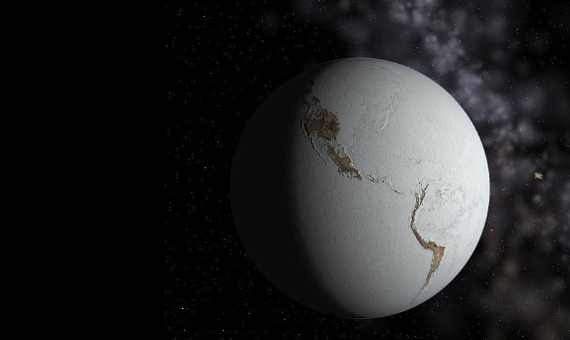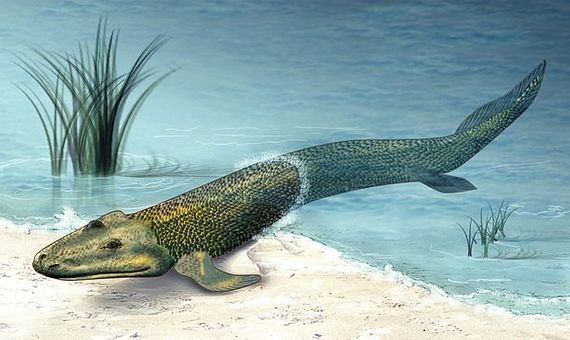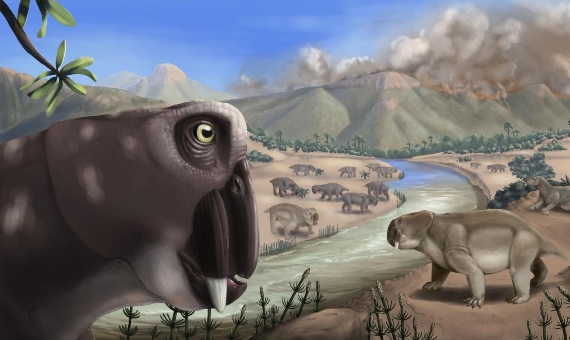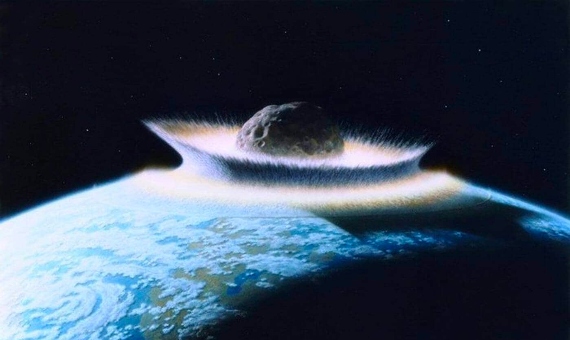In 2016, a meeting of scientists defined a new geological epoch, the Anthropocene, which would succeed the Holocene starting from the mid-20th century and which is characterised by the profound impact of the human footprint on the planet. One of the most pronounced features of this new period—which has not yet been ratified by the relevant bodies—is an accelerated mass extinction of species that has been described as the sixth such mass event, and the first caused by one of those species: us. Numerous major extinctions have occurred throughout Earth’s history, but only a few meet the criteria for the Big Five: periods of less than 2.8 million years in which three-quarters of species have disappeared. To understand the significance of these catastrophes, we review here these five episodes—and one additional one—that were due to natural causes and changed the course of evolution and life on Earth.
0 – 2.4-2 billion years ago: The Great Oxidation Event
Although not usually included in the five great extinction events, it was undoubtedly the first major shock to biological evolution: between 2.4 and 2.05 billion years ago, in the Paleoproterozoic Era, the atmosphere and the surface of the oceans began to fill with oxygen, a gas that until then had been a very minor component of the Earth’s atmosphere. It is assumed that photosynthetic microorganisms were responsible for this phenomenon known as the Great Oxidation Event, although it is still debated whether cyanobacteria or other more primitive microbes were the main culprits, as well as the causes behind this dramatic transformation.

Whatever the causes, however, the result was a radical change. An oxygen-rich atmosphere made life as we know it today possible, but in return it wiped out the single-celled creatures that had dominated the planet until then and for whom oxygen was a poison. The consequences were even more profound: the decline in methane, a potent greenhouse gas that was previously abundant in the atmosphere, plunged the Earth into a global deep freeze now known as the Huronian glaciation. This dramatic U-turn in the course of Earth’s history warns us of the extreme sensitivity of the climate to ecological perturbations.
1 – 443 million years: Ordovician-Silurian extinctio
For more than two billion years of life on Earth, only single-celled organisms existed, until about 575 million years ago, when the first multicellular organisms began to appear, a phenomenon called the Avalon explosion. This diversification, made possible by the end of global glaciation, still hides many secrets from science. One of them is the extent to which fauna of the Ediacaran period left descendants in the great burst of life that occurred shortly afterwards, 540 million years ago: the Cambrian explosion.

The Cambrian gave birth to the major faunal lineages from which most of today’s animals are descended, although life was then still limited to water and its shores. But about 443 million years ago, and almost overnight in geological time, 85% of the species disappeared from the planet. It is said that a vast glaciation covered Gondwana, the southern supercontinent, and caused sea levels to fall, dooming the creatures that inhabited the continental shelves. This was followed by a subsequent rapid warming that again raised water levels but left oceans poor in oxygen and rich in toxic metals. The causes of this are not yet well understood; it has been proposed that the emergence of the Appalachian mountain range in the present-day USA by tectonic movements exposed new rock whose chemical weathering removed CO2 from the atmosphere, thus reducing the greenhouse effect. Other theories speak of volcanism or a gamma-ray burst from a supernova that would have removed the protection of the atmospheric ozone against the Sun’s lethal ultraviolet radiation.
2 – 372 million years ago: Late Devonian extinction
About 419 million years ago, the Devonian Period began, known today as the Age of Fishes, as these animals grew and diversified until they colonised almost every known aquatic environment; one of them, the Dunkleosteus, reached almost 9 metres in length. Vertebrates also began to timidly leave the waters to venture onto dry land with their fins, which, as in the case of the tiktaalik, gradually transformed into legs to give rise to the first tetrapods (four-limbed vertebrates). But the Devonian was also when the Earth became green: plants covered the landscape forming large forests that were populated by invertebrates such as myriapods, arachnids and the first insects.

A series of extinction events began in the late Devonian that lasted millions of years and together wiped out up to 75% of all species. The gradual nature of the second great extinction in Earth’s history has led to multiple hypotheses about its causes, including the usual ones such as volcanism or the impact of an object from space. One interesting theory is that it was plants that caused it all: with no herbivores to control their proliferation, the explosion of plant life caused a sharp drop in atmospheric CO2 that reduced the greenhouse effect, triggering global cooling. This was coupled with the release of nutrients into the oceans by the action of plants on rock, with a consequent algal bloom that removed oxygen from the water. The Devonian extinction only affected aquatic species. The trilobites, one of the most successful groups of the Palaeozoic, lost most of their species.
3 – 252 million years ago: Permian-Triassic extinction
About 252 million years ago, what is considered to be the largest extinction in Earth’s history occurred, so extensive as to mark the death of one era, the Palaeozoic, and the birth of another, the Mesozoic, which we know today as the reign of the dinosaurs. The cause of the Great Dying, as it is known colloquially, is usually attributed to a massive volcanic episode that originated in the region known as the Siberian Traps, releasing large amounts of CO2 that caused catastrophic global warming, although the possible impact of a space object has not been ruled out. The result was the extinction of more than 85% of marine species in just 100,000 years. And while it was the definitive end for some iconic Palaeozoic animals, such as the few trilobites that had survived the two previous extinction events, the extinction on land may have been more prolonged and affected 70% of the fauna, including numerous reptiles, amphibians and insects.

According to a 2021 study, the extinction was followed by a proliferation of bacteria and algae in the waters that turned them into a toxic, uninhabitable soup for hundreds of thousands of years; it took some four million years for the Earth to recover, and coral reefs would not return to their former glory until 14 million years later. The study’s authors warned that the same thing is happening in today’s climate emergency: excessive nutrient dumping and warming seas are causing this eutrophication, which consumes oxygen in the water, creating dead zones and releasing large amounts of the greenhouse gas N2O into the atmosphere.
4 – 201 million years: Triassic-Jurassic extinction
The Triassic, the first period of the Mesozoic era, is a 50-million-year span flanked by two of the great terrestrial extinction events. It was not until the middle of this period that life began to recover the diversity it had before the catastrophe at the end of the Permian, only for a new volcanic cataclysm in the region of today’s Atlantic Ocean—according to the current hypothesis—to release immense quantities of CO2 shortly afterwards, causing a global warming and acidification of the oceans that were devastating for the biosphere.

With the disappearance at the end of the Permian of many of the therapsids, the first mammals, it was reptiles that began to dominate the Earth in the Triassic, a period with a warm, dry climate. The end of this period saw the appearance of dinosaurs and pterosaurs—the first flying vertebrates—but by then it was the ancestors of crocodiles that were the dominant group. This changed with the great extinction event that wiped out 80% of species, decimating mainly crocodiles and mammals, and allowing dinosaurs to become the kings of the Jurassic, the later period.
5 – 66 million years: Cretaceous-Tertiary extinction
The last of the five great extinctions is undoubtedly the most popularly known, as it marked the end of the age of the dinosaurs. It is widely believed that the cataclysm was caused by the impact of Chicxulub, a 12-kilometre asteroid that stuck the planet near the present-day Mexican Yucatan peninsula with the power of 10 billion atomic bombs, opening a crater 150 kilometres in diameter and 20 kilometres deep. The global cooling and darkening it produced wiped out three-quarters of all life on Earth, especially the larger animals. An alternative hypothesis has circulated for years, attributing the so-called K-T or K-Pg (Cretaceous-Tertiary or Cretaceous-Palaeogene) extinction event to a phenomenon of volcanism that caused the so-called Deccan traps in present-day India. Although the Chicxulub theory is the most widely accepted, it is now thought that volcanoes also contributed to the disastrous end result.

However, it is not entirely accurate to say that dinosaurs became extinct, as not all of them actually did. From the group of avian dinosaurs—smaller animals that survived the catastrophe—originated all modern birds, which current taxonomy also classifies as dinosaurs in their own right. The disappearance of the great reptiles gave mammals, until then small creatures hiding underground, their chance to multiply and populate the planet, until they gave rise to human beings, the only species capable of initiating a great extinction by itself at a much faster rate than nature has ever managed.
Comments on this publication